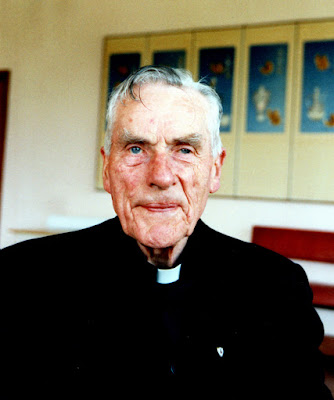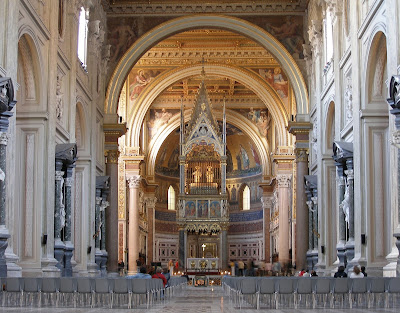Nave of the Archbasilica of St John Lateran [Wikipedia]
The Cathedral of Rome, the ‘Mother of all Churches’
Readings (New American Bible: Philippines, USA)
Readings (Jerusalem Bible: Australia, England & Wales, India [optional], Ireland, New Zealand, Pakistan, Scotland, South Africa)
Gospel Luke 21:5-19 (NewRevised Standard Version, Catholic Edition)
When some were speaking about the temple, how it was adorned with beautiful stones and gifts dedicated to God, Jesus said, “As for these things that you see, the days will come when not one stone will be left upon another; all will be thrown down.”
They asked him, “Teacher, when will this be, and what will be the sign that this is about to take place?” And he said, “Beware that you are not led astray; for many will come in my name and say, ‘I am he!’ and, ‘The time is near!’ Do not go after them.
“When you hear of wars and insurrections, do not be terrified; for these things must take place first, but the end will not follow immediately.” Then he said to them, “Nation will rise against nation, and kingdom against kingdom; there will be great earthquakes, and in various places famines and plagues; and there will be dreadful portents and great signs from heaven.
“But before all this occurs, they will arrest you and persecute you; they will hand you over to synagogues and prisons, and you will be brought before kings and governors because of my name. This will give you an opportunity to testify. So make up your minds not to prepare your defense in advance; for I will give you words and a wisdom that none of your opponents will be able to withstand or contradict. You will be betrayed even by parents and brothers, by relatives and friends; and they will put some of you to death. You will be hated by all because of my name. But not a hair of your head will perish. By your endurance you will gain your souls.
Earthquake destroys Basilica of St Benedict on 30 October 2016
Norcia (or Nursia) is the place where St Benedict was born c.480
This Sunday falls between two celebrations of church buildings in Rome, the Feast of the Dedication of the Lateran Basilica on 9 November and the Optional Memorial of the Dedication of the Basilicas of Saints Peter and Paul on 18 November. When the former falls on a Sunday its celebration takes precedence over the Sunday. The official name of the Lateran Basicilica is the Archbasilica of the Most Holy Saviour and of Saints John the Baptist and the Evangelist and is the Cathedral of the Diocese of Rome.
In the gospel Jesus speaks of the future destruction of the Temple where he had worshipped all his life, where he had been presented to the Father as an infant by Mary and Joseph, from which he threw the moneylenders because they were turning it into a market.
On 30 October the Basilica of St Benedict in his birthplace Norcia in Italy was destroyed in seconds by a powerful earthquake as if fulfilling the words of Jesus today, all will be thrown down.

Destroyed Basilica of St Benedict [Source:The Monks of Norcia]
In today’s gospel Jesus warns us of wars and insurrections . . . great earthquakes . . . famine and plagues . . . You will be hated by all because of my name.
We are seeing all of these things in our time. They can lead us to lose hope – if we forget the closing words of Jesus in today’s gospel: But not a hair of your head will perish. By your endurance you will gain your souls.
On 4 October this year Hurricane Matthew caused great destruction in southwestern Haiti, the poorest country in the Western Hemisphere. But the Sunday Examiner, the weekly newspaper of the Catholic Diocese of Hong Kong carried the following report in its issue for 30 October.
Port-au-Prince. Survivors of Hurricane Matthew put on their Sunday finest as they picked their way through rubble and downed power lines to gather in ruined churches on October 9, just three days after the devastating storm ravaged their homes.
Photographs posted on news websites show pews in the open air, with the rubble from the hurricane piled to one side, as a neatly clad congregation in suits and ties, smart slacks and dresses made a colourful scene in what had once been churches with roofs.
Mass celebrated in Qaraqosh, Iraq, after its recent liberation
Archbishop Youhanna Boutros Moshe is the Syrian Catholic Archbishop of Mosul
In 2104 Christians were driven out of Mosul and nearby cities in Iraq by ISIS, also known as Daesh. For the first time in nearly 2,000 years Mass could not be celebrated in the area. But on Sunday 30 October Mass was celebrated again in the Church of the Immaculate Conception, Qaraqosh, near Mosul.
A church building is where Christians gather to celebrate the Eucharist, the Holy Mass, where they meet and receive the Risen Lord. Down the centuries Christian communities have built churches that are beautiful in order to draw people into the beauty and life of the Blessed Trinity. And even if the building is destroyed by an earthquake as in Norcia, by a hurricane as in southwestern Haiti, or by persecution as in Qaraqosh, Iraq, the Lord is still present to and among the Christian community, especially when believers come together on Sunday, as Jesus Christ has asked us to do, to celebrate his life, death and Resurrection, and our hope in eternal life, in the Holy Sacrifice of the Mass.
By your endurance you will gain your souls.



Antiphona ad Communionem
Communion Antiphon Mark 11:23-24
Amen dico vobis, quidquid orantes petitis,
Amen, I say to you: whatever you ask in prayer,
credite quia accipientis, et fiet vobis, [dicit Dominus].
believe that you will receive, and it shall be given to you, [says the Lord].

